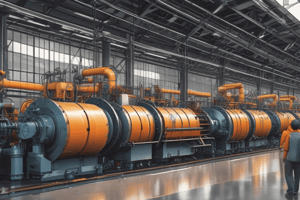Podcast
Questions and Answers
What percentage of the area under the curve represents a 95 per cent confidence level?
What percentage of the area under the curve represents a 95 per cent confidence level?
- 99.9%
- 99%
- 95% (correct)
- 68%
What is the standard normal deviate for a 95 per cent confidence level?
What is the standard normal deviate for a 95 per cent confidence level?
- 2.58
- 3.3
- 1.96 (correct)
- 1.64
What percentage of the time will observations reflect the facts if we take a large sample at random?
What percentage of the time will observations reflect the facts if we take a large sample at random?
- 99.9%
- 95% (correct)
- 68%
- 99%
What is the formula for a 99 per cent confidence level?
What is the formula for a 99 per cent confidence level?
What is the percentage of the area under the curve that represents a 99.9 per cent confidence level?
What is the percentage of the area under the curve that represents a 99.9 per cent confidence level?
What is the confidence level represented by 2 σ limits?
What is the confidence level represented by 2 σ limits?
What is the standard normal deviate for a 99 per cent confidence level?
What is the standard normal deviate for a 99 per cent confidence level?
What percentage of the cases will our observations fall within ± 1.96 σp?
What percentage of the cases will our observations fall within ± 1.96 σp?
What is the purpose of setup elements in a production process?
What is the purpose of setup elements in a production process?
What type of elements are characterized by little or no random variations?
What type of elements are characterized by little or no random variations?
What is the formula to compute the batch time of a production?
What is the formula to compute the batch time of a production?
What is the unit of measurement for the quantity 'Q' in the batch time formula?
What is the unit of measurement for the quantity 'Q' in the batch time formula?
What is the difference between operator-paced elements and machine-controlled elements?
What is the difference between operator-paced elements and machine-controlled elements?
What is the result of increasing the quantity 'Q' in the batch time formula?
What is the result of increasing the quantity 'Q' in the batch time formula?
What does a plateau near the X-axis in the learning curve reflect?
What does a plateau near the X-axis in the learning curve reflect?
What is the final stage of the learning curve often referred to as?
What is the final stage of the learning curve often referred to as?
What is the name of the model created by T.P. Wright?
What is the name of the model created by T.P. Wright?
What happens to the cumulative average columns when production is doubled?
What happens to the cumulative average columns when production is doubled?
What happens to the average overall in columns 2 and 4 when production is doubled?
What happens to the average overall in columns 2 and 4 when production is doubled?
What is the primary purpose of the Mento-factor system?
What is the primary purpose of the Mento-factor system?
What is the formula to get XYh?
What is the formula to get XYh?
What is the abbreviated time unit used in the Mento-factor system?
What is the abbreviated time unit used in the Mento-factor system?
What is the expected accuracy of the abbreviated systems compared to the detailed system?
What is the expected accuracy of the abbreviated systems compared to the detailed system?
How would you calculate the cost to manufacture 10 more units if the company has already produced 8 units?
How would you calculate the cost to manufacture 10 more units if the company has already produced 8 units?
What is the direct labor cost per hour?
What is the direct labor cost per hour?
What is the main advantage of using the Mento-factor system?
What is the main advantage of using the Mento-factor system?
What is the Ready Work Factor system used for?
What is the Ready Work Factor system used for?
What is the main purpose of the Ready Work Factor system?
What is the main purpose of the Ready Work Factor system?
What is the task described in the Work Sampling example?
What is the task described in the Work Sampling example?
What is considered in the Work Sampling example?
What is considered in the Work Sampling example?
What is the purpose of calculating the midpoint unit in Crawford's model?
What is the purpose of calculating the midpoint unit in Crawford's model?
What is the symbol for the algebraic midpoint of a specific production batch or lot in Crawford's model?
What is the symbol for the algebraic midpoint of a specific production batch or lot in Crawford's model?
What can be used instead of K to find the unit cost of any particular or specific quantity or unit?
What can be used instead of K to find the unit cost of any particular or specific quantity or unit?
What is the unit cost of the midpoint unit in Crawford's model?
What is the unit cost of the midpoint unit in Crawford's model?
What is the formula to calculate the lot cost in Crawford's model?
What is the formula to calculate the lot cost in Crawford's model?
What is the symbol for the incremental unit time (or cost) of the lot midpoint unit in Crawford's model?
What is the symbol for the incremental unit time (or cost) of the lot midpoint unit in Crawford's model?
What is the purpose of using the algebraic midpoint of the lot in Crawford's model?
What is the purpose of using the algebraic midpoint of the lot in Crawford's model?
What is the relationship between the lot cost and the unit cost of the midpoint unit in Crawford's model?
What is the relationship between the lot cost and the unit cost of the midpoint unit in Crawford's model?
Flashcards are hidden until you start studying
Study Notes
Production Elements
- Setup elements are activities required to change over from one batch to the next, performed once per batch
- Production elements are associated with the processing of work units within a given batch, performed once per work unit
- Batch time (Tb) is the sum of setup time (Tsu) and cycle time (Tc) multiplied by quantity (Q): Tb = Tsu + Q Tc
Worker-Paced and Machine-Controlled Elements
- Worker-paced elements are manual elements that can be setup or production cycle elements
- Machine-controlled elements are machine time that depends on machine operating parameters and can be determined with great accuracy
Other Work Element
- Mento-Factor System is a fundamental tool for calculating mental processes such as examinations, proofreading, color matching, and calculation
Practice
- Ready Work Factor System is used to assess manual labor in manufacturing and other industries
- The system uses an adapted approach with a higher-level job factor to provide a simple measurement method
Work Sampling
- Work sampling is a method of observing and recording the activities of workers at random intervals to determine the proportion of time spent on different tasks
- 95% confidence level means that observations will reflect the facts 95% of the time and not represent the facts 5% of the time
Learning Curve Model
- There are two models of learning curves: Wright's Cumulative Average Model and Crawford's Incremental Unit Time (or Cost) Model
- Wright's model is more readily introduced for simple learning curve problems, while Crawford's model is commonly used in practice
- The learning curve model shows how production costs decrease as the quantity of production increases due to labor efficiency and learning effects
Studying That Suits You
Use AI to generate personalized quizzes and flashcards to suit your learning preferences.





